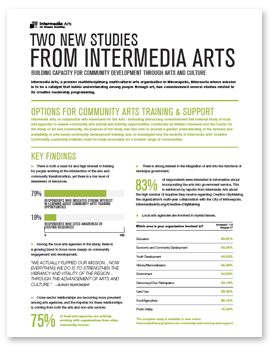In the fall of 2015, Intermedia Arts joined with Animating Democracy at Americans for the Arts to sponsor a CSA&C study designed to learn more about where community arts training is currently taking place and where there may be future interest.
The research was undertaken from September 22 to October 9, 2015 by The Center for the Study of Art & Community. The study cohort was comprised of leadership from 423 local arts agencies who had previously indicated their interest and/or involvement in community arts programming in the 2015 Americans for the Arts local arts agency census. The response rate for the 18-day study was a relatively high 34%.
The survey consisted of three sets of Likert scale questions each with multiple items, and five questions soliciting narrative responses. There were three general areas of inquiry. These were:
- Organizational Activity: The level of community arts support and activity undertaken by responding organizations.
- Community Activity: The level of community arts activity and support in the responding organizations constituent communities.
- Interest Level: Respondent interest in future community arts programming as well as support in areas such as training, funding, partnerships, and programming.
This summary provides a one page overview of key findings in the study. The full report is also availale here.
Intermedia Arts, in conjunction with Americans for the Art' Animating Democracy program commissioned this national study of local arts agencies to asess community arts activity and training opportunities. The study was conducted by William Cleveland and the Center for the Study of Art and Community. Its purpose was two-fold: to provide a greater understanding of the demand and availability of arts-based community development training; and, to investigate how the benefits of Intermedia Arts' Creative Community Leadership Institute could be made accessible for a broader range of communities.This summary provides a one page overview of key findings in the study. The full report is also available here.


Most Commented